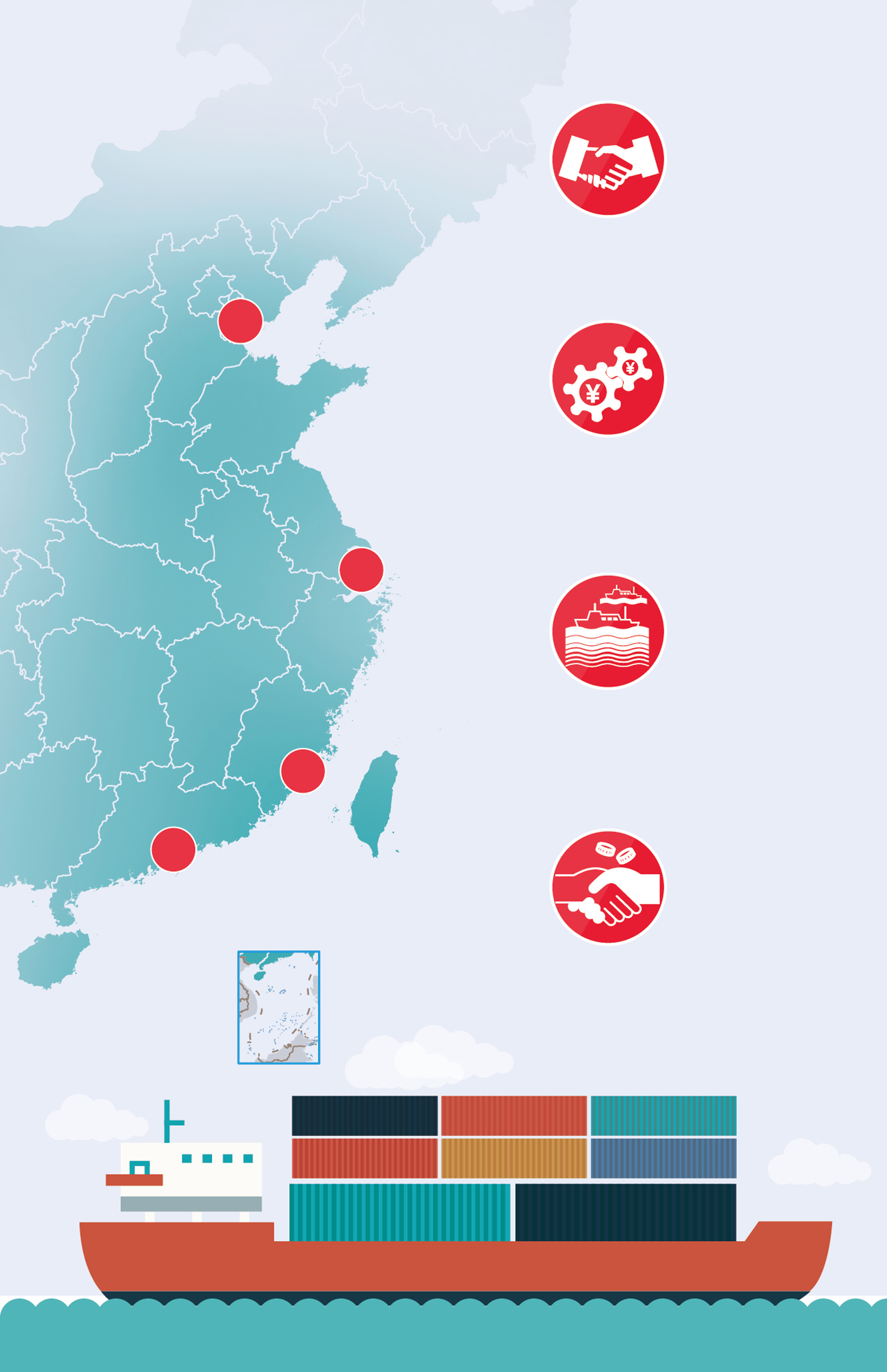Free trade zones

China has created three new free trade zones in Tianjin Municipality, Fujian and Guangdong provinces modeled on one established 18 months ago in Shanghai as the government tries to promote reform and opening-up.
Following the success of the pilot free trade zone (FTZ) in Shanghai, new zones were opened in Tianjin Municipality, and Guangdong and Fujian provinces on April 21. It symbolizes China’s FTZ construction has entered a new development period and depicts a pattern for reform and opening-up.
“The four FTZs from north to south advance the strategy of opening to the outside world to new heights, further exploring a new channel for deepening reform and opening-up,” said Zhang Zhanbin, director of the Department of Economics at the Chinese Academy of Governance.
FTZs with distinct characteristics
After evaluating the overall schemes of these four FTZs, it can be found that there are 71 items of measures for reform and innovation, in which Shanghai has 25, Tianjin and Fujian Province have 16 each and Guangdong Province has 14. In addition to the common tasks of stepping up the transition of governmental functions, enlarging opening-up and innovation in investment and financial fields, and innovating the trade supervisory system, they also have their own characteristics.
The Shanghai FTZ pays more attention to advancing investment and trade facilitation, free convertibility of currencies, market admittance, convenient commercial regulation and efficient customs clearance.
The Guangdong FTZ will focus on optimizing marketization, building a healthy legal environment and deepening Guangdong-Hong Kong-Macao cooperation.
With deepening facilitation of investment and the services trade, Tianjin will continue to manifest its unique advantages in high-end manufacturing, financial innovation and port logistics. The Tianjin FTZ aims to promote the economic coordination in the Beijing-Tianjin-Hebei region to construct a comprehensive and multilevel pattern for regional economy.
The biggest characteristic of the Fujian FTZ is its trade platform with Chinese Taiwan, which is consistent with Fujian’s development and advantages. It will pay great attention to the personnel exchange and economic and trade relations between the Chinese mainland and Taiwan.
“It is a key task to promote the successful experience of the Shanghai FTZ nationwide under the aim of comprehensively deepening reform and opening-up, rather than building more FTZs,” said Wang Shouwen, an assistant minister in the Ministry of Commerce.
New tides may be triggered
For the establishment of the four FTZs, some experts analyzed that the cluster of FTZs has been formed along the coastal area of eastern China, aiming to realize the transition of manufacturing and upgrading of professional services and bring greater openness to the financial field as well as benefit Hong Kong, Macao special administrative regions and Taiwan.
Jin Lei, deputy director of the Shanghai Taiwan affairs office, said that it is expected to motivate the overall transition of manufacturing within the Chinese mainland, Hong Kong, Macao and Taiwan.
Some enterprises from Hong Kong and Taiwan that have benefited from the Shanghai FTZ predict that these four FTZs may trigger a new tide of merchants from Hong Kong, Macao and Taiwan “going north and west.”
“It can be seen that some European and American financial institutions have put their main focus on Asia against the backdrop of the rise of the yuan. With the establishment of more FTZs in the Chinese mainland, the government is bound to launch more free financial policies. Taiwan, Hong Kong and Macao should make efforts to engage in the process of regional economic integration,” said a senior employee from the Shanghai bureau of Taiwan Capital Securities.
The same ‘negative list’
The four FTZs in Shanghai, Tianjin, Guangdong and Fujian provinces are undoubtedly test fields for China to promote a new round of reform. Although possessing their own local characteristics, they still need to adopt the “negative list” mode for realizing investment and trade facilitation and stepping up financial reform.
Wang claimed that the newly established FTZs will adhere to the same negative list as the Shanghai FTZ, and adopt innovative measures including institutional innovation.
Currently, the State Council has launched a negative list for the four FTZs. The negative list is used to relax restrictions on foreign investment, while any field excluded from the list should allow foreign investment.
The new negative list details 122 prohibited or restricted areas for foreign investment, including Internet news services, production of radio and television programs and non-ferrous metal mining. This number has been reduced from 139 in 2014. Some experts analyzed that this change marks the government’s determination to delegate power, adding it will make FTZs more open and transparent.
